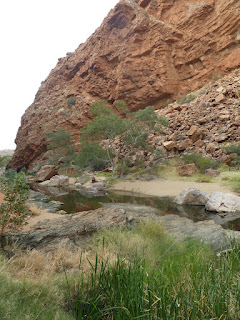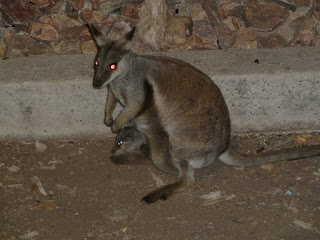We enjoyed our stay at the previous night's motel so much that I inquired at checkout about staying another night, but unfortunately they were all booked. Nate did some research however, and discovered a place on the outskirts of town that was known for rock wallaby sightings, so he made a reservation there instead. I called about camel rides, and got us a reservation, much to my excitement. We spent the morning walking around downtown Alice Springs, such as it is, and getting stocked up on toiletries, postcards, and groceries. I actually felt really comfortable in this town, and it felt like the truest Australia we’d yet to see. It was the Australia romantics imagine – rough and tumble, yet with a heart of gold. The people here were the friendliest, too. I was trying to locate a restaurant and asked our grocery clerk, and a patron nearby overheard and jumped in with the location. So nice! While shopping, I wound up finding what I thought was a great deal on shower puffs, since mine had just fallen apart. It was something like $2 for 6. Well, it turned out that each one only lasted about two showers, but they’d at least get me through the trip because of all the car sleeping we’d be doing. Makes you wonder about pride in ones product, but oh well.
As we wandered around, we decided to climb Anzac Hill, the most prominent geological feature right in the heart of downtown. It had a war memorial on top, as well as a geocache, which we found. We enjoyed the views from up there, surveying the small city below as well as the mesas and desert all around. There had been many fires in the area, so it was all a bit hazy, but still quite scenic. Despite the topography, the entire region is considered one of the most geologically stable areas in the world with no volcanoes and very few earthquakes. It is an interesting region. Once we’d had our fill of town, we realized it was almost time to ride our camels. I really didn’t know what to expect, but I’d always wanted to do this. I’d been on an elephant as a kid at Busch Gardens, and ridden countless horses, but never a camel. Nate had ridden a camel at the zoo before, and isn’t much for horseback riding, so he was less enthused about this entire thing, and I have to admit I was getting a bit nervous myself upon approach. I always thought camels were a bit ornery and unpredictable, but it turns out that this wasn’t the case, at least with the ones at Pyndon.
We pulled up to the lot and waited for another group to join us before heading over. It was a very informal set-up, with the owner collecting money for the tours and the guide standing by, chit chatting with everyone. I really liked the guide a lot. He was the most stereotypical Aussie we’d met the entire trip. A lifelong naturalist, he spent his youth chasing down lizards and catching bugs and birdwatching. Everything I’d done as a kid. Through the years, he studied wildlife more and had a lot of experience working with camels along the way. He’d answer a number of our questions and was really a wealth of information. Quite the character indeed!
Once everyone had arrived, we headed over to the fenceline where all the camels were tethered. Inside the paddock were a mother and young baby camel, who was frolicking around adorably, so we got to observe that as we waited. Our guide gave us our camel first, and it turned out that we would be in the lead. We were given Trillian, one of the oldest camels around, and most mellow it would seem. The feat of having to climb way up into the saddle (each saddle is custom-made to fit each individual’s hump structure) was made easier by the camels, who would merely lay down until you were ready to go. In fact, it seemed that whenever they weren’t out walking, they were lying down.
Nate and I both climbed into the saddle, me in the front, and him in the back, and we were instructed to lean backward and forward as she laboriously hefted herself up. It was pretty intense, but fun too. We waited atop Trillian as the other members of our trip mounted and rose into the air. It was exciting up so high, much higher than any horse. Yet it felt comfortable. We wound up chatting with the two older ladies who were right behind us. They were doing a whistle stop tour of Australia, visiting from England, and were just lovely to speak with. They even gave us some advice on where to eat while in Darwin, which we wound up following later.
Once everyone was up and ready to go, our guide came and took Trillian’s lead. We walked out into the desert, and he told us all about what wildlife sign to try to see. He pointed out tracks from kangaroo tails, identified strange birds, and, most excitingly, pulled a Crocodile Hunter on us when he spotted an enormous yellow bearded dragon. He dropped Trillian’s reins and grabbed the creature, getting bitten up and bloody in the process. Undeterred, he proudly took the lizard up to each of us for an excellent photo op. Very cool.
He also told us a lot about the camels we were riding, their origins (many of which were wild captured in the outback), and how they differ in training from horses. It sounds like, instead of reining and kicking, camels respond to verbal cues to turn. Unlike horses who respond to rewards like treats and petting, a camel’s reward is to be ignored by people. They don’t like attention. It sounds like camels are more predictable and generally safer to deal with than horses, too, if you know enough about their habits. They don’t spook and are more even tempered in many cases. Nate actually really enjoyed the camels and told me that he’d rather have a camel than the horse I’ve been pulling for all these years. Maybe I’ll take him up on it!
As for the Australian wild camels, there are nearly 1 million camels, mostly dromedaries, roaming the outback. These are the descendants of camels that were brought over before transportation technology advanced across the continent. It turns out, they’re very well adapted to the Australian outback and can eat about 80 percent of the plants available. While they’re an invasive species, so far they haven’t done too much damage, only really being a problem in densities higher than two per square km. Unfortunately, they tend to double in population every 9 years, so that may change. Interestingly, Australia is the only place in the world that you can observe dromedary camels exhibiting truly wild behavior, so that is exciting. I would have loved to have seen some wild ones, but that wasn’t in the cards on this trip.
Once we made it back to the ranch, we asked about interesting sites to see while in The Alice. He suggested we not miss Bojangles, a touristy pub of sorts, so we took note and headed back into town.
Our first order of business was to get some food. We’d heard that Red Ochre restaurant was known for its distinctly Australian cuisine, so that’s what we did. We shared the combo platter which included a lamb wrap, kangaroo steak, and camel sausage. We really did feel bad eating camel after having just fallen in love with them, but it did taste good. The kangaroo was tough and unimpressive. I don’t really remember the lamb, but I think it was alright. We weren’t that thrilled with anything we got there, though. After our meal, we headed to Bojangles, which was all done up like a wild west saloon and had crocodile skins and other outback kitsch hanging all over the place. Nate got a Northern Territory beer of some sort, and I had my beloved Lemon Ruski. It was an interesting and seemingly rough (though whimsical) place. Definitely worth a stop when in The Alice.
After this, we checked in at the Heavitree Gap Resort. Despite the name, it was actually a lower end motel attached to a campground. We did get an ensuite room, though, and it was mere feet away from where the rock wallabies would appear around dusk. Once signed in, we hit the road again for more adventuring.
We drove west of town and stopped at West MacDonnell National Park for some scenic hiking along a creek bed. We tried to spot some rock wallabies here, to no avail, but the scenery made up for it. We also stopped a little further up, and back at a memorial on our way back, but nothing too exciting. We had to hurry back to make it in time for the dusk wallaby feedings.
Once back at the motel, we bought a bag of wallaby chow from the front desk and headed over to the rocky hillside where people had already converged. On top of that, there were around 30 rock wallabies already milling around the area, some of which were eating wallaby chow right out of peoples’ hands. There was also a really little joey who looked like it was searching for its mom. It kept trying to crawl into a lady’s purse. I just wanted to scoop it up and take it home with me. We had the most incredible time coaxing these wild creatures to us and marveling at them up close as they ate. Some were really greedy and would hold your hand with their paws so you wouldn’t leave until they had their fill. Their fur was a bit coarse, and most of them had ticks, which was a bit unpleasant, but I doubt they transferred to humans. I’m not sure I agree with letting people interact this closely with wildlife, but it doesn’t seem to cause any problems, and hopefully it won’t in the future. Hopefully close interactions will help to educate people and make them more aware and concerned about wildlife around them. As a species, the black footed rock wallaby is a vulnerable species due to predation by feral cats and foxes, but in this region, their numbers seem to be doing well.
From there, Nate and I found the on-site laundry facility, and I filled out postcards while he did the laundry. Then we enjoyed a beer at the on-site pub before visiting with the wallabies one more time and then calling it a night.












No comments:
Post a Comment